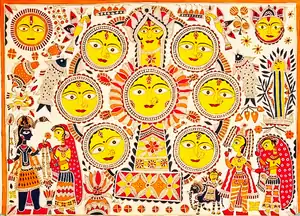Mithila culture
Mithila culture or Maithil culture refers to the culture which originated in the Mithila region of the Indian subcontinent. Mithila comprises Tirhut, Darbhanga, Kosi, Purnia, Munger, Bhagalpur and Santhal Pargana divisions[lower-alpha 1] of India[1] and some adjoining districts of Nepal.
Paintings

Madhubani art (Mithila painting) is practiced in the Mithila region of India and Nepal. It was traditionally created by the women of different communities of the Mithila region. It is named after Madhubani district of Bihar, India which is where it originated.[2] This painting as a form of wall art was practiced widely throughout the region; the more recent development of painting on paper and canvas originated among the villages around Madhubani, and it is these latter developments that may correctly be referred to as Madhubani art.[3]
Headgear

The Paag is a headdress native to the Mithila region worn by Maithil people. It is a symbol of honour and respect and a significant part of the Maithil culture.[4]
Dances
Jhijhiya
Jhijhiya is a cultural dance from the Mithila region of India and Nepal.[5] Jhijhiya is mostly performed at time of Dusshera, in dedication to Durga Bhairavi, the goddess of victory.[6] While performing jhijhiya, women put lanterns made of clay on their head and they balance it while they dance.[7]
Domkach
Domkach is a folk dance of the Mithila region.[8]
Cuisine
See also
- Indian culture
- Nepalese culture
- Maithili language
- Mithila, India
- Mithila, Nepal
- Bihari culture
References and footnotes
Notes
- Santhal Pargana division is headquartered at Dumka and the cited source mentions the division as "Dumka division"
- Jha, Pankaj Kumar (2010). Sushasan Ke Aaine Mein Naya Bihar. Bihar (India): Prabhat Prakashan. ISBN 9789380186283.
- Madhubani Painting. 2003. p. 96. ISBN 9788170171560. Archived from the original on 28 October 2017. Retrieved 20 February 2017.
- Carolyn Brown Heinz, 2006, "Documenting the Image in Mithila Art," Visual Anthropology Review, Vol. 22, Issue 2, pp. 5-33
- http://timesofindia.indiatimes.com/city/patna/Donning-Mithilas-paag-in-Houses/articleshow/53480415.cms
- Nishi Sinha (1999). Tourism Perspective in Bihar. APH. p. 39. ISBN 9788170249757.
- Punam Kumari (1999). Social and cultural life of the Nepalese. Mohit Publications. ISBN 978-81-7445-092-0. Retrieved 16 August 2013.
- Nishi Sinha (1999). Tourism Perspective in Bihar. APH. p. 40. ISBN 9788170249757.
- http://folklibrary.com/index.php/folkform/?id=211-domkach&catid=210&parent=&child=Domkach&color=
- http://epaper.navbharattimes.com/details/59768-68289-1.html
- http://www.angelfire.com/home/mithila/maithilcusine.htm
- https://www.pakwangali.in/sweet-recipes/how-to-make-bagiya-sweet-snacks-recipe-in-hindi/article/971505.html